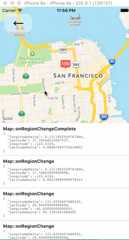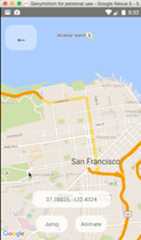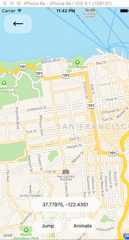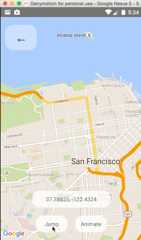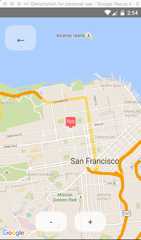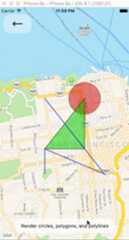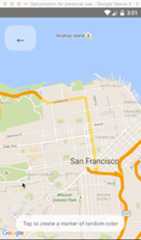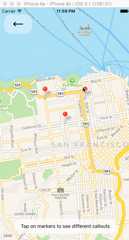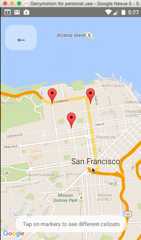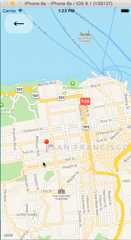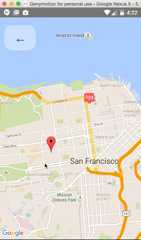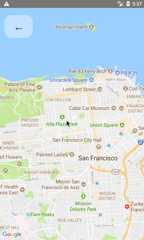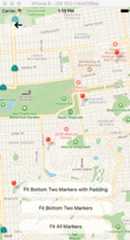Uh oh!
There was an error while loading.Please reload this page.
- Notifications
You must be signed in to change notification settings - Fork5k
React Native Mapview component for iOS + Android
License
react-native-maps/react-native-maps
Folders and files
| Name | Name | Last commit message | Last commit date | |
|---|---|---|---|---|
Repository files navigation
React Native Map components for iOS + Android
This project is being maintained by a small group of people, and any help with issues and pull requests are always appreciated. If you are able and willing to contribute, please read theguidelines.
SeeSetup Instructions for the Included Example Project.
| Version | React Native Requirement |
|---|---|
| 1.26.1+ | >= 0.81.1 |
| 1.26.0 and below | >= 0.76 |
| Version | React Native Requirement |
|---|---|
| 1.14.0 - 1.20.1 | >= 0.74 |
| < 1.14.0 | >= 0.64.3 |
importMapViewfrom'react-native-maps';
or
varMapView=require('react-native-maps');
This MapView component is built so that features on the map (such as Markers, Polygons, etc.) arespecified as children of the MapView itself. This provides an intuitive and react-like API fordeclaratively controlling features on the map.
<MapViewinitialRegion={{latitude:37.78825,longitude:-122.4324,latitudeDelta:0.0922,longitudeDelta:0.0421,}}/>
getInitialState(){return{region:{latitude:37.78825,longitude:-122.4324,latitudeDelta:0.0922,longitudeDelta:0.0421,},};}onRegionChange(region){this.setState({ region});}render(){return(<MapViewregion={this.state.region}onRegionChange={this.onRegionChange}/>);}
import{Marker}from'react-native-maps';<MapViewregion={this.state.region}onRegionChange={this.onRegionChange}>{this.state.markers.map((marker,index)=>(<Markerkey={index}coordinate={marker.latlng}title={marker.title}description={marker.description}/>))}</MapView>;
- You need to generate an
pngimage with various resolution (lets call themcustom_pin) - for more information go toAndroid,iOS - put all images in Android drawables and iOS assets dir
- Now you can use the following code:
<Markercoordinate={{latitude:latitude,longitude:longitude}}image={{uri:'custom_pin'}}/>
Note: You can also pass the image binary data likeimage={require('custom_pin.png')}, but this will not scale good with the different screen sizes.
Note: This has performance implications, if you wish for a simpler solution go with a custom image (save your self the headache)
<Markercoordinate={{latitude:latitude,longitude:longitude}}><MyCustomMarkerView{...marker}/></Marker>
import{Callout}from'react-native-maps';<Markercoordinate={marker.latlng}><MyCustomMarkerView{...marker}/><Callout><MyCustomCalloutView{...marker}/></Callout></Marker>;
<MapViewinitialRegion={...}><Markerdraggablecoordinate={this.state.x}onDragEnd={(e)=>this.setState({x:e.nativeEvent.coordinate})}/></MapView>
import{UrlTile}from'react-native-maps';<MapViewregion={this.state.region}onRegionChange={this.onRegionChange}><UrlTile/** * The url template of the tile server. The patterns {x} {y} {z} will be replaced at runtime * For example, http://c.tile.openstreetmap.org/{z}/{x}/{y}.png */urlTemplate={this.state.urlTemplate}/** * The maximum zoom level for this tile overlay. Corresponds to the maximumZ setting in * MKTileOverlay. iOS only. */maximumZ={19}/** * flipY allows tiles with inverted y coordinates (origin at bottom left of map) * to be used. Its default value is false. */flipY={false}/></MapView>;
For Android: add the following line in your AndroidManifest.xml
<uses-permissionandroid:name="android.permission.INTERNET" />
For IOS: configureApp Transport Security in your app
Tiles can be stored locally within device using xyz tiling scheme and displayed as tile overlay as well. This is usefull especially for offline map usage when tiles are available for selected map region within device storage.
import{LocalTile}from'react-native-maps';<MapViewregion={this.state.region}onRegionChange={this.onRegionChange}><LocalTile/** * The path template of the locally stored tiles. The patterns {x} {y} {z} will be replaced at runtime * For example, /storage/emulated/0/mytiles/{z}/{x}/{y}.png */pathTemplate={this.state.pathTemplate}/** * The size of provided local tiles (usually 256 or 512). */tileSize={256}/></MapView>;
For Android: LocalTile is still just overlay over original map tiles. It means that if device is online, underlying tiles will be still downloaded. If original tiles download/display is not desirable set mapType to 'none'. For example:
<MapView mapType={Platform.OS == "android" ? "none" : "standard"}>SeeOSM Wiki for how to download tiles for offline usage.
Place components that you wish to overlayMapView underneath theMapView closing tag. Absolutely position these elements.
render(){return(<MapViewregion={this.state.region}/><OverlayComponentstyle={{position:"absolute",bottom:50}}/>);}
The<MapView provider="google" googleMapId="yourStyledMapId" /> Google Maps on iOS and Android supports styling via google cloud platform, the styled maps are published under a googleMapId, by simply setting the property googleMapId to the MapView you can use that styled mapmore info here:google map id
The<MapView /> component and its child components have several events that you can subscribe to.This example displays some of them in a log as a demonstration.
One can change the mapview's position using refs and component methods, or by passing in an updatedregion prop. The component methods will allow one to animate to a given position like the nativeAPI could.
The<MapView /> component can be made to work with the Animated API, having the entireregion propbe declared as an animated value. This allows one to animate the zoom and position of the MapView alongwith other gestures, giving a nice feel.
Further, Marker views can use the animated API to enhance the effect.
Issue: Since android needs to render its marker views as a bitmap, the animations APIs may not becompatible with the Marker views. Not sure if this can be worked around yet or not.
Markers' coordinates can also be animated, as shown in this example:
So far,<Circle />,<Polygon />, and<Polyline /> are available to pass in as children to the<MapView /> component.
Gradient polylines can be created using thestrokeColors prop of the<Polyline> component.
Default markers will be rendered unless a custom marker is specified. One can optionally adjust thecolor of the default marker by using thepinColor prop.
Callouts to markers can be completely arbitrary react views, similar to markers. As a result, theycan be interacted with like any other view.
Additionally, you can fall back to the standard behavior of just having a title/description throughthe<Marker />'stitle anddescription props.
Custom callout views can be the entire tooltip bubble, or just the content inside of the systemdefault bubble.
To handle press on specific subview of callout use<CalloutSubview /> withonPress.SeeCallouts.js example.
Markers can be customized by just using images, and specified using theimage prop.
Markers are draggable, and emit continuous drag events to update other UI during drags.
Enable lite mode on Android withliteMode prop. Ideal when having multiple maps in a View or ScrollView.
Poi are clickable, you can catch the event to get its information (usually to get the full detail from Google Place using the placeId).
The MapView can accept anAnimatedRegion value as itsregion prop. This allows you to utilize the Animated API to control the map's center and zoom.
importMapView,{AnimatedRegion,Animated}from'react-native-maps';getInitialState(){return{region:newAnimatedRegion({latitude:LATITUDE,longitude:LONGITUDE,latitudeDelta:LATITUDE_DELTA,longitudeDelta:LONGITUDE_DELTA,}),};}onRegionChange(region){this.state.region.setValue(region);}render(){return(<Animatedregion={this.state.region}onRegionChange={this.onRegionChange}/>);}
Markers can also accept anAnimatedRegion value as a coordinate.
importMapView,{AnimatedRegion,MarkerAnimated}from'react-native-maps';getInitialState(){return{coordinate:newAnimatedRegion({latitude:LATITUDE,longitude:LONGITUDE,}),};}componentWillReceiveProps(nextProps){constduration=500if(this.props.coordinate!==nextProps.coordinate){if(Platform.OS==='android'){if(this.marker){this.marker.animateMarkerToCoordinate(nextProps.coordinate,duration);}}else{this.state.coordinate.timing({ ...nextProps.coordinate,useNativeDriver:true,// defaults to false if not passed explicitly duration}).start();}}}render(){return(<MapViewinitialRegion={...}><MarkerAnimatedref={marker=>{this.marker=marker}}coordinate={this.state.coordinate}/></MapView>);}
importMapView,{Marker}from'react-native-maps';getInitialState(){return{coordinate:{latitude:LATITUDE,longitude:LONGITUDE,},};}takeSnapshot(){// 'takeSnapshot' takes a config object with the// following optionsconstsnapshot=this.map.takeSnapshot({width:300,// optional, when omitted the view-width is usedheight:300,// optional, when omitted the view-height is usedregion:{..},// iOS only, optional region to renderformat:'png',// image formats: 'png', 'jpg' (default: 'png')quality:0.8,// image quality: 0..1 (only relevant for jpg, default: 1)result:'file'// result types: 'file', 'base64' (default: 'file')});snapshot.then((uri)=>{this.setState({mapSnapshot:uri});});}render(){return(<View><MapViewinitialRegion={...}ref={map=>{this.map=map}}><Markercoordinate={this.state.coordinate}/></MapView><Imagesource={{uri:this.state.mapSnapshot.uri}}/><TouchableOpacityonPress={this.takeSnapshot}> Take Snapshot</TouchableOpacity></View>);}
Pass an array of marker identifiers to have the map re-focus.
Pass an array of coordinates to focus a map region on said coordinates.
- Make sure that you haveproperly installed react-native-maps.
- Check in the logs if there is more informations about the issue.
- Try setting the style of the MapView to an absolute position with top, left, right and bottom values set.
- Make sure you have enabled Google Maps API inGoogle developer console
conststyles=StyleSheet.create({map:{ ...StyleSheet.absoluteFillObject,},});
<MapViewstyle={styles.map}// other props/>
- When inputs don't focus or elements don't respond to tap, look at the order of the view hierarchy, sometimes the issue could be due to ordering of rendered components, prefer putting MapView as the first component.
Bad:
<View><TextInput/><MapView/></View>
Good:
<View><MapView/><TextInput/></View>
Components that aren't declared by this library (Ex: Markers, Polyline) must not be children of the MapView component due to MapView's unique rendering methodology. Have your custom components / views outside the MapView component and position absolute to ensure they only re-render as needed.Example:Bad:
<Viewstyle={StyleSheet.absoluteFillObject}><MapViewstyle={StyleSheet.absoluteFillObject}><Viewstyle={{position:'absolute',top:100,left:50}}/></MapView></View>
Good:
<Viewstyle={StyleSheet.absoluteFillObject}><MapViewstyle={StyleSheet.absoluteFillObject}/><Viewstyle={{position:'absolute',top:100,left:50}}/></View>
Source:#1901
<MapView> using Apple Maps inmapType: "standard" will sometimes crash when you background the app or switch into another app. This is only an issue in XCode using Metal API Validation, and won't happen in production. To eliminate this problem even while debugging in XCode, go toEdit Scheme... -> Run (Debug) -> Diagnostics and uncheckMetal -> API Validation. (h/t@Simon-TechForm).
Source:#3957 (comment)
If changing the state inonRegionChangeComplete is called infinitely, add a condition to limit these calls to occur only when the region change was done as a result of a user's action.
onRegionChangeComplete={(region,gesture)=>{// This fix only works on Google Maps because isGesture is NOT available on Apple Mapsif(!gesture.isGesture){return;}// You can usedispatch({type:"map_region",payload:{mapRegion:region}});// if using useReducer// setMapRegionState(region); // if using useState}}
Source:#846 (comment)
Copyright (c) 2017 Airbnb Licensed under the The MIT License (MIT) (the "License"); you may not use this file except in compliance with the License. You may obtain a copy of the License at https://raw.githubusercontent.com/airbnb/react-native-maps/master/LICENSE Unless required by applicable law or agreed to in writing, software distributed under the License is distributed on an "AS IS" BASIS, WITHOUT WARRANTIES OR CONDITIONS OF ANY KIND, either express or implied. See the License for the specific language governing permissions and limitations under the License.About
React Native Mapview component for iOS + Android
Topics
Resources
License
Contributing
Security policy
Uh oh!
There was an error while loading.Please reload this page.
Stars
Watchers
Forks
Sponsor this project
Uh oh!
There was an error while loading.Please reload this page.
